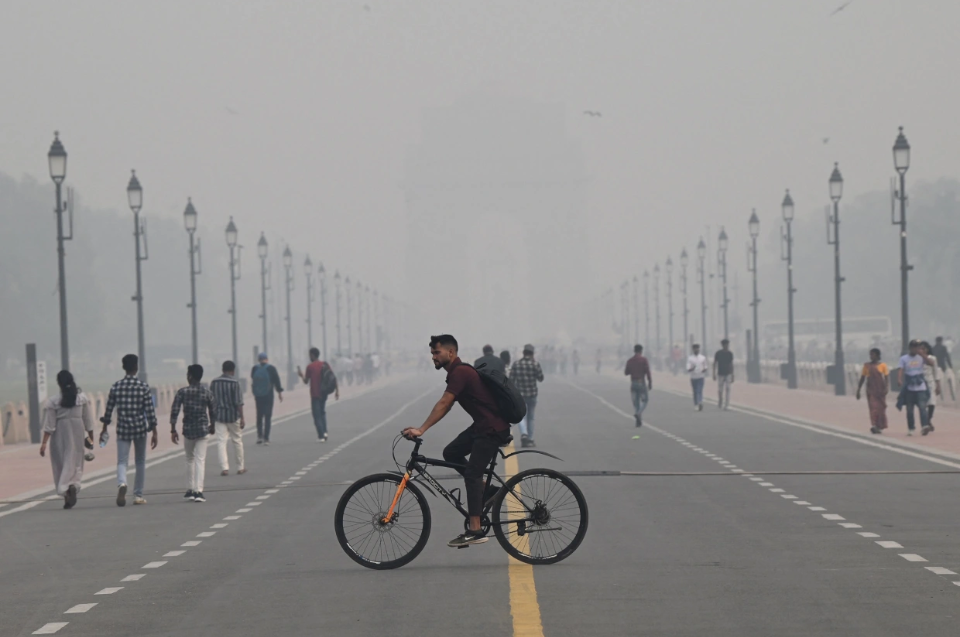
©Arun Thakur / AFP – Getty Images
Vocabulary:
I will read the words, meanings, and sample sentences. Then, repeat after me.
- detrimental /de-truh-MEN-tl/
- vulnerable /VUHL-ner-uh-buhl/
- irritation /ir-i-TEY-shuhn/
- severity /suh-VER-i-tee/
- vitality /vahy-TAL-i-tee/
[adjective] – causing harm or damage
The detrimental effects of smoking are well-documented.
[adjective] – able to be easily physically or mentally hurt, influenced, or attacked
The elderly are vulnerable to heat-related illnesses during extreme weather conditions.
[noun] – a painful or sore feeling in a part of the body
The pollen in the air caused irritation in her eyes.
[noun] – seriousness
The severity of the storm led to widespread damage across the city.
[noun] – energy and strength
His daily exercise routine boosts his vitality, keeping him energetic throughout the day.
Article reading:
Please read the whole article. Then, I will check your pronunciation and intonation.
In urban India, notably New Delhi, combating escalating air pollution remains a critical challenge. Recent environmental circumstances have significantly affected everyday life, compounded by sluggish winds and crop fires. The rise in fine particulate matter (PM 2.5) has prompted school closures and limitations on outdoor activities, driven by health concerns from the Air Quality Index (AQI) exceeding safe levels, especially detrimental to vulnerable groups.
Efforts to mitigate this crisis involve transitioning classes online and witnessing a notable increase in demand for indoor air purifiers. However, beyond health implications, the pervasive pollution significantly impacts social activities and public life. The heightened AQI levels, reaching nearly 480, have raised concerns among healthcare professionals due to respiratory distress among children and discomfort among residents. New Delhi grapples with a severe haze, a result of escalating air pollution, with the AQI hitting alarming levels. Factors such as stagnant winds and crop residue burning in nearby regions contribute to eye irritation and throat discomfort among residents. Efforts to combat rising pollution involve advising school closures and increasing interest in air purifiers to alleviate indoor pollution. However, the haze’s influence extends beyond health, impacting outdoor activities and social interactions, reducing the city’s liveliness. The severity of this urban air pollution necessitates urgent, comprehensive solutions, emphasizing the need to address root causes and implement stricter regulations. Collaborative efforts are crucial to safeguard public health and restore the vitality of urban life in New Delhi.
Efforts to mitigate this crisis involve transitioning classes online and witnessing a notable increase in demand for indoor air purifiers. However, beyond health implications, the pervasive pollution significantly impacts social activities and public life. The heightened AQI levels, reaching nearly 480, have raised concerns among healthcare professionals due to respiratory distress among children and discomfort among residents. New Delhi grapples with a severe haze, a result of escalating air pollution, with the AQI hitting alarming levels. Factors such as stagnant winds and crop residue burning in nearby regions contribute to eye irritation and throat discomfort among residents. Efforts to combat rising pollution involve advising school closures and increasing interest in air purifiers to alleviate indoor pollution. However, the haze’s influence extends beyond health, impacting outdoor activities and social interactions, reducing the city’s liveliness. The severity of this urban air pollution necessitates urgent, comprehensive solutions, emphasizing the need to address root causes and implement stricter regulations. Collaborative efforts are crucial to safeguard public health and restore the vitality of urban life in New Delhi.
Discussion Questions:
I will read each question. Then, please answer them.
- Have you experienced or witnessed the effects of severe air pollution on everyday life, like school closures or limitations on outdoor activities, in your community or city? If yes, how did these measures impact your routine and well-being? If not, how do you imagine such environmental challenges might affect daily life and the activities you enjoy?
- Have you or someone you know utilized air purifiers or other measures to mitigate indoor air pollution caused by external factors like haze or poor air quality? If yes, what was your experience with these solutions, and did they help alleviate any health concerns? If not, how do you think individuals or communities might cope with the impact of pervasive pollution on their day-to-day lives and overall health?
- Do you think the current measures taken to combat air pollution in urban areas, such as school closures and increased use of air purifiers, are sufficient to effectively tackle the broader environmental issues caused by pollution?
- Do you believe that the impact of urban air pollution extends beyond health concerns to significantly affect social interactions, community vibrancy, and overall quality of life in affected cities? Why or why not?
- In your opinion, what comprehensive and innovative approaches could be implemented to address urban air pollution beyond short-term measures, ensuring long-term sustainability and improved quality of life for city residents?
Summarization
Please summarize the whole article using your own words and expressions. You will have one minute to prepare before you answer.
Describe:
Please explain the definition of each word listed below based on your understanding. You can provide example sentences if needed.
- alarming
- discomfort
- respiratory
- purifier
- crop residue